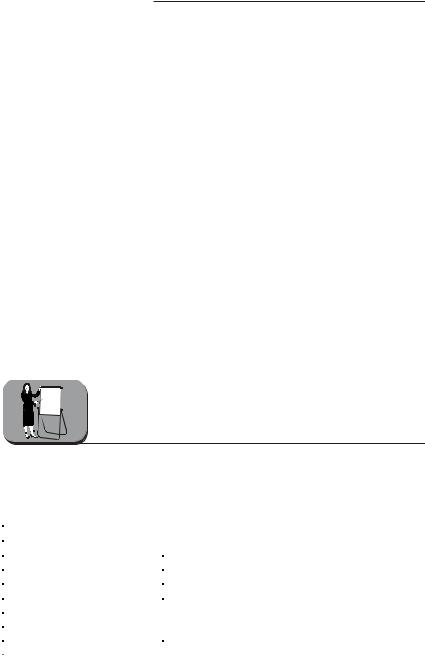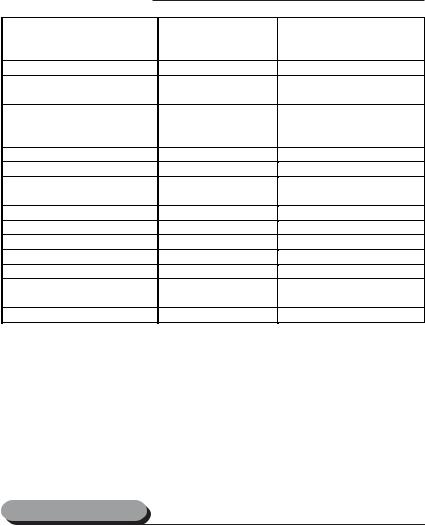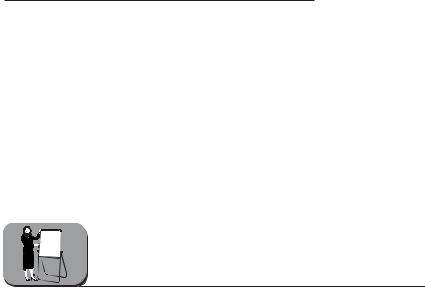
English для юристов. Гончар
.pdf
Part ІI. BASIC COURSE
Reading tasks
1. Read the text and pay attention to the words describing appearance
Note on the text:
«Neighbourhood watch» — «Сусідський контроль» (Neighbourhood Watch is the best known and most effective example of the community working together to prevent crime, reduce the fear of crime and improve quality of life. Over 155,000 Neighbourhood Watch schemes operate throughout the United Kingdom covering up to 25% of all households.
The concept of Neighbourhood Watch was brought back to the UK in 1982 from the United States by a group of police officers who had visited Chicago. The first scheme was set up in the village of Mollington in Cheshire in res5 ponse to a spate of burglaries and was an immediate suc5 cess. Good news travelled fast and surrounding areas were quick to adopt the idea. Growth throughout the 1980s was dramatic establishing Neighbourhood Watch country5 wide. It is now the largest voluntary organisation in the UK. Neighbourhood Watch schemes can be large or small. They are generally led by a volunteer co5ordinator whose job is to get people working together and make sure things get done. As well as the co5ordinator there is usually a committee who meet regularly to plan which problems to target and what action to take. Sch5 emes keep in close touch with the local police to share information and advice.)
«Well, well, what do we have here…,» Tim Wisdom is opening his favourite daily newspaper «The Gazette».
He usually reads it every evening. Now he is sitting on the sofa on the ground floor of his cottage and looking through the headlines. There seems to be nothing particularly interesting in this issue. «I have already read all the titles, and there is no article to spend the evening with,» Tim thinks sadly. But suddenly huge letters attract his attention: WANTED. As an active «Neighbourhood Watch» member, Tim has always been interested in such materials. He studies the article carefully.
«Wanted for armed robbery. 23 December, Ealing Broadway trade centre. At 4.25 p.m. the suspect entered the pet shop armed with a big white staff and demanded, «Give me two kilos of deer food, or else!..» Then he disappeared in the crowd. The suspect is described as a white male, age unknown, medium height, well5built. Round face, fair hair, bushy eyebrows, pale complexion. Prominent red nose, full lips, plump
30

Module 1. Unit 2
cheeks, massive chin. Heavy bearded. He was dressed in red gown with white fur, red hat and gloves.
If you have any information about the suspect, contact the Police immediately.»
«Mr. Sanders?» an idea appears in Tim’s mind, «But no, his face is not round, it’s rather square. This is Jim Redford from Park Lane! But… His lips are thin, and his nose is hooked. And, for God’s sake, what does he need the deer food for?!»
«I have a good idea,» Tim says to himself, «I am going to walk along the streets and watch for the strangers. No, I have a better idea, really the best one! I am going to discuss the matter with the friends in the pub!» With these words Tim leaves the house and suddenly sees the suspect right near the opposite house! Mr. Wisdom grabs the man, disarms him, puts him in his car and takes him to the police station.
AN HOUR LATER. «Sergeant Reeves!» the voice of constable Dobson is very serious. «Neighborhood Watch» activist Wisdom has arrested five suspects.»
«And?..»
«And we are having now five Santas in our cells! This Christmas joke of «The Gazette» was the most stupid one!»
2.In the text there are a lot of examples connected with a verbal personal physical description. List them in the columns below and add three more examples of your own to each column.
Sex |
Race |
Figure/Height |
Face |
Hair/ |
Peculiarities |
|
|
|
|
Bearded |
|
|
|
|
|
|
|
! |
UNDERSTANDING MAIN POINTS |
|
3. Answer the following questions:
1.Why is an identification important in police\militia?
2.Why does Mr. Wisdom consider Mr. Sanders not to be the wanted person?
*Gr. note: Subjective infinitive construction перекладається як «здається, що…»
31

Part ІI. BASIC COURSE
3.Why was Mr. Redford not identified as the suspect?
4.Why does Constable Dobson consider the Christmas joke to be the most stupid one?
4.PREPOSITIONS. Choose the right preposition in brackets accor ding to the contents of the sentences (with, in, on, by, of, to, for, along, ).
1.The portrait parle was devised … Alphonse Bertillon.
2.An identi5kit may be transmitted by telegraph … other agencies.
3.My neighbour is wanted … armed robbery.
4.The reference to fingerprints as ‘the prints from man’s hands can be found … the Bible.
5.The students of Law Academy of Ukraine are very interested … the records.
6.What does he look like? — The victim was described as a black female … a middle size with a pimpled face and dyed hair.
7.The policemen were walking … the central street of the town and watching … the strangers very carefully.
8.That evening a wanted man armed …a gun walked into Foxy’s wine store and got away with $3, 000.
9.There was an expression of surprise … his face.
10.The thief grabbed … the rope, but missed and fell to his death.
BUILD UP YOUR VOCABULARY
5.A. What points of information should be obtained (if possible) for a complete description of a person in the process of identification? List them filling in the chart, use topic vocabulary if necessary.
|
Points |
Description (choice) |
1. |
Sex |
Male / female |
2. |
Age |
|
3. |
Race/nationality/colour |
|
4. |
Height |
|
5. |
Figure |
|
6. |
Face / forehead |
|
7. |
Hair / bearded/ moustaches |
|
8. |
Eyebrows / eyes / lashes |
|
32

|
|
|
Module 1. Unit 2 |
|
|
||
9. Nose |
Straight/hooked/flat/aquiline/snub-nosed |
||
10. |
Chin/ |
|
|
|
jaw |
|
|
11. |
Mouth/ |
|
|
|
teeth/ |
|
|
|
lips |
|
|
12. |
Neck |
|
|
13. |
Ears |
Big / small/ lop-eared |
|
14. |
Arms, |
|
|
|
hands and fingers |
|
|
15. |
Legs and feet |
|
|
16. |
Fingerprints |
Arches / whorls/ loops |
|
17. |
Physical defects |
|
|
18. |
Clothing |
|
|
19. |
Blood |
Type |
|
20. |
Peculiarities |
|
|
21. |
Behavioral |
|
|
characteristics |
|
|
|
22. Name |
|
|
|
|
|
|
|
23. |
Characteristic |
+ Sociable, calm, composed, just, industrious, |
|
|
|
clever, intelligent, capable, devoted, strong-willed, |
|
|
|
attentive, witty, gentle, easy-going; |
|
|
|
- unkind, ill-natured, cruel, insensible, envious, |
|
|
|
selfish, boring, tactless, fussy, dishonest, coarse |
|
|
|
|
|
B.Ask questions about any person to get similar information. Fill in the chart with the information concerning the suspect presented in the text and your own suspect.
|
Points |
Description of the Person |
|
|
The Suspect from |
Your Suspect |
|
|
|
the text |
|
1. |
Sex |
|
|
2. Age |
|
|
|
3. |
Race/nationality/colour |
|
|
4. |
Height |
|
|
5. |
Figure |
|
|
6. |
Face / |
|
|
|
forehead |
|
|
7. |
Hair / |
|
|
|
bearded/moustaches |
|
|
33

Part ІI. BASIC COURSE
8.Eyebrows/
eyes/ lashes
9.Nose
10.Chin/ jaw
11.Mouth/
teeth/ lips
12.Neck
13.Ears
14.Arms,
hands and fingers
15.Legs and feet
16.Fingerprints
17.Physical defects
18.Clothing
19.Blood
20.Peculiarities (characteristics)
21.Name
6.Find in the text:
a) antonyms for the following words:
to appear |
female |
hollow cheeks |
thin eyebrows |
to arm |
known |
blooming complexion |
straight nose |
b) synonyms for the following words:
a daily number, a heading, chubby cheeks, to catch, merrily, sallow complexion
Post reading tasks
1. Describe any person sitting next to you or anyone of your fellow students and other students must listen to your description and guess the name of this person. Use words from the text including such
lexical patterns as: |
|
|
5 seems |
5 looks like |
5 to take after |
5 appears |
5 to be as like as two peas |
5 to look alike |
5 strikes me |
5 Who/What does he look like? |
|
34

Module 1. Unit 2
2.Computer Dating Information Form.
Ask your friend any questions (and write them down) about desirable appe arance and characteristics of his/her future partner (wife or husband).
3.Translate into English in writing
Розшукується Криводід Миколай Олександрович, 1968 року народження, народився у м. Одеса, національність — українець.
Його прикмети: зріст 187см, міцної будови, волосся чорняве, кучеряве; зачиска коротка, шия тонка, довга; ніс кирпатий, очі сірі, може носити окуляри.
Був одягнутий у джинси, чорний светр та піджак, шкіряну куртку темно5зеленого кольору, чорні шкіряні черевики.
BUILD UP YOUR VOCABULARY
4.What methods of investigation which are used in the process of detection do you know?
Match each of these words with the correct definitions: use the Ukrainian equivalents in brackets below (if necessary):
a) identification |
1.a set of pictures of different features that can be |
|
fitted together to form the face of a person |
b) identi5kit |
2. a person’s particular style of writing |
c) voiceprinting |
3. a process of taking somebody’s fingerprints |
d) fingerprinting |
4. a process of making a distinctive spectrographic |
|
pattern of a person’s voice |
e) photography |
5. a process of identifying |
f) handwriting |
6. a process of taking a photo |
g) portrait parle |
7. a verbal picture or description of a human body |
h) artist sketch |
8. a process of drawing a sketch of somebody |
(розпізнавання або встановлення особи; словесний портрет; фоторобот; ескіз художника; знімання відбитків пальців; фото; запис голосу; почерк)
35

Part ІI. BASIC COURSE
5.Physical Appearance and Description. Complete the following questionnaire in pairs. Then compare the results in groups.
1.When you first meet somebody, what do you look at first?
a.their hair
b.their face
c.their eyes
d.their mouth
e.the clothes they are wearing for
f.the back of their body
g.the front of their body
h.other (please specify)
2.Which of the following will make you think most positively about someone?
a.They are attractive
b.They are well5groomed
c.They are smiling
d.They look interesting
e.other (please specify)
3.Which of the following will make you think most negatively about someone?
a.They aren’t good5looking
b.They are frown
c.They are smiling
d.They look strange
e.other (please specify)please specify
4.Think of two people that you find unusual and striking. What is the most physically unusual and striking thing about them?
5.Think of two people that you find very attractive. What is the most physically attractive thing about them?
6.Think of two people that you find very suspicious. What does a common thief/murder/terrorist look like?
6. Write down a title of the text of your own.
OVER TO YOU
1.Read, translate into Ukrainian and prove that the proverbs have sense.
1. The face is the index of the mind.
36

Module 1. Unit 2
2.Never judge by appearance.
3.A man is as old as he feels, and a woman is as old as she looks.
2.Which of the following parts of the body can go with these verbs? One verb often goes with more than one part of the body and vice versa.
1. head |
a. wave |
2. fist |
b. incline |
3. finger |
c. clench |
4. hands |
d. point |
5. arms |
e. wiggle |
6. legs |
f. wag |
7. eyebrow |
g. fold |
8. hand |
h. hunch |
9. shoulder |
i. shrug |
10. hips |
j. nod |
11. teeth |
k. raise |
12. ear |
l. cross |
|
m. shake |
3. Metaphors from the body. Match the pairs:
1. head |
a. of the law |
2. long arm |
b. for fighting |
3. hand |
c. of the company |
4. heart |
d. of Fate |
5. no stomach |
e. of the matter |
4.Compose the dialogue with your partner and play it in pairs or write a letter where you ask your friend in the airport to meet your sister and give her description. The problem and danger is that she is much alike with a wanted criminal arriving and landing at the same time that makes difficult to recognize her.
LANGUAGE FOCUS
The Present Continuous Tense
1.Make the following sentences interrogative and negative: Example: The police are making inquires now. — Are the police making inquires now? No, the police are not making inquires now.
37

Part ІI. BASIC COURSE
1. He is opening his favourite newspaper. 2. He is sitting on the sofa and looking through the headlines. 3. Look, the suspect is entering the pet shop. 4. They are discussing the matter with the friends in the pub. 5. The officers are disarming the suspect. 6. Now we are having five Santas in our cells!
2.Put questions to the words in italics:
Example: The deputies are discussing the new bill. — What are the deputies discussing?
1.The suspect is wearing the red gown with white fur, red hat and gloves. 2. They are discussing the details of the crime in the office. 3. The policemen are bringing the accused out of the courtroom. 4. The reporters are interviewing the criminal. 5. Mr. Wisdom is taking the suspect to the police station. 6. He is looking rather strange: prominent red nose, full lips, plump cheeks, massive chin, heavy beard.
3.Choose the correct form (Present Simple or Present Continuous): Example: Listen, the judge (announces/ is announcing) the sentence.
— Listen, the judge is announcing the sentence.
1.I don’t understand him, he (is demanding/ demands) two kilos of deer food.
2.Experts (examine/ are examining) the fingerprints. 3. Huge letters (attract/ are attracting) his attention: WANTED. 4. Tim (leaves/ is leaving) the house and suddenly (sees/ is seeing) the suspect right near the opposite house! 5. I (have/ am having) a better idea, really the best one! 6. The clerk (checks/ is checking) the copies of the documents.
4.Translate into English:
1.Дивись! Підозрюваний вибігає з магазину і кричить щось.
2.Невідомий білий чоловік з бородою тримає гаманець у руці.
3.Що ти робиш? — Я читаю свою улюблену газету. 4. Це телефонує активіст Віздом, він тримає підозрюваного та веде його до дільниці. 5. Сержант Рівз та констебль Добсон роз5 зброюють злочинця. 6. Тепер ми маємо п’ятьох Санта Клаусів у в’язниці!
38

Module 1. Unit 2
The Numeral
1.Read and write the cardinal numerals in words:
a)3; 13; 30; 4; 14; 40; 5; 15; 50; 2; 12; 20; 8; 18; 80; b)21;82; 35; 44; 33; 55; 96; 67; 79; 41; 53; 22;
c)143; 258; 414; 331; 972; 568; 441; 999 230; d)1 562; 3 013; 5 612; 9 444;
e)234 673; 569 034; 11 390; 456 190; 556 782;
f)1 232 585; 35 890 562; 352 789 209.
2.Form, read and write the ordinal numerals in words:
a)7; 4; 8; 9; 5; 12; 3; 2; 1; 13; 15; 11; 10;
b)20; 21; 30; 32; 40; 43; 50; 54; 60; 75; 80; 98;
c) 100; 120; 125; 200; 230; 231; 300; 450; 563; 892.
3.Read and write in words the following dates:
9.03.1814; 22.04.1941; 9.05.1945; 23.11.1928; 30.11.1982; 1.12.1991; 31.10.1999.
4.Do the sums:
3 + 4 = |
12 x 13 = |
195 — 70 = |
54 |
/ 9 = |
|
|||
14 + 15 = 6 x 7 = |
16 — 9 = |
45 / 9 = |
|
|||||
18 + 19 = 6 x 6 = |
17 — 8 = |
24 / 3 = |
|
|||||
5. Read and write in words the following fractions: |
|
|
||||||
1/7 |
1/5 |
1/9 |
1/15 |
2/5 |
4/7 |
9/23 |
2 5/7; |
|
3,5 |
1,1 |
0,1 |
52,51 |
0,302 |
|
132,054. |
|
|
The Adjective. Degrees of comparison
1. Write the comparative and superlative of the following adjectives:
a)white, great, active, fine, brave, deep, short, round, fair, pale, thin, full;
b)hot, fat, bushy, big, easy, dry, dirty, silly, happy;
c)old, far, good, bad, little, much, many;
d)reliable, interesting, important, useful, efficient, difficult, applicable, certain, appropriate, ambiguous, relevant, consistent, satisfactory.
39
